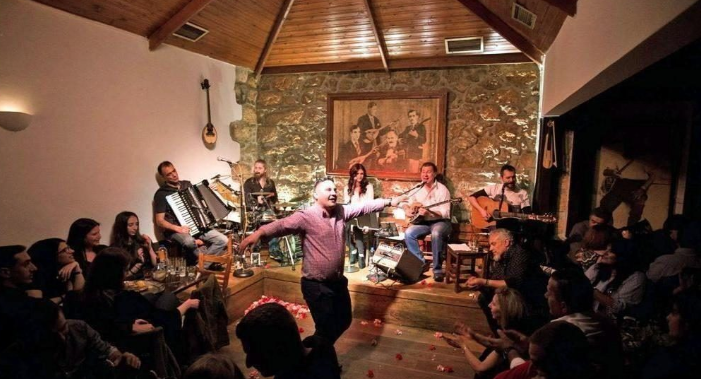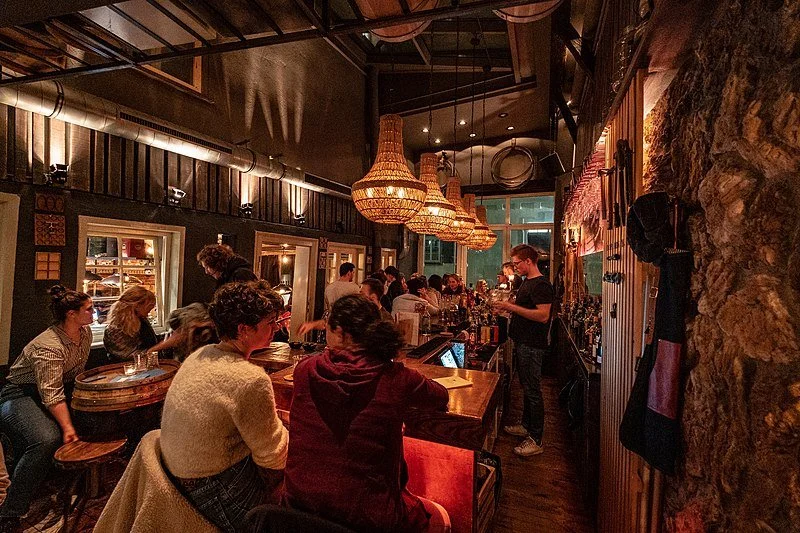Regulars of the World, Unite!
Pop-up Meyhane by Istanbul Elsewhere, London, photo by Ferhat Elik
Despite the seismic changes we witnessed in global entertainment culture in the last two decades or so, many around the world still cherish the idea of being able to have a few drinks, perhaps a bite or two, in a relaxed environment that not only allows but in a certain way demands them to be nothing but themselves. These unpretentious, friendly if not cozy, traditional, affordable, and local spaces offer their regulars a refuge from the oscillations, trials and tribulations, and the vertiginous pace of change that defines our age.
Taverna
Taverna in Naxos, source: wikimedia
Like its doppelgänger from across the Aegean Sea, the taverna is, for its regulars, a home away from home.
The origins of taverna go back to ancient Athens, circa 2500 BCE. Kapeleia (plural of kapeleion), as the taverns were known at the time, offered regulars including women and slaves a place to drink wine other than the symposia, where aristocrats drank, danced, and gluttonized. In other words, the kapeleia were communal hubs, public arenas for the people, and after two millennia of transformation in every aspect of life, they’ve preserved that definitive trait.
Taverna still emanates a sense of community brought together by their love of the space, of sharing, of good food and drinks, and of course conversation. Like its doppelgänger from across the Aegean Sea, the taverna is, for its regulars, a home away from home – a place where the regulars know they will always be welcome, treated amicably but with respect, and allowed – or, perhaps better put, encouraged – to be themselves.
“The square, she asked, what will we do at the square? I know a little taverna there; it’s in a basement, there’s wine and a juke box, the sort of place working people go to, said Dimitri, do you mind? Rather than sit in a boring café or tea-room – personally, yes, he definitely preferred the local taverna. As you wish, she said, not wanting to spoil his pleasure. To be sure, she had never been to a working-class taverna in a basement before…The place resounded with the noise of clashing plates, blaring music, gusts of loud laughter.”
Menis Koumandareas, Koula.
Rebatadiko Tou Spiri in Athens - source: www.rebetadiko-psiri.gr
The collegial, embracing, unreserved atmosphere of the taverna is captured brilliantly by Niki Troullinou’s in her short story “With a Crate of Beer”: “She told him the brief story of her life with that ease created by evenings in tavernas with a bit of wine and a portion of fresh fish, the exposed, tanned bodies of fellow diners, deep laughter, a contemporary hit song on the radio, the cats quarreling over fish heads.”
Rebetadiko in Athens, soruce: www.athens24.com
Some of the different types of taverna that locals refer to by their specific names include:
Mezedopolio: Famous for their mezes; offering a variety of alcoholic beverages.
Rebetadiko: Live band plays rebetiko. In terms of food, they offer mezes and casserole dishes. Wine, beer, and other alcoholic beverages are available.
Tsipouradiko, rakadiko, ouzeri: Specialising in tsipouro, rakı, and ouzo respectively. Shared dishes are made from seasonal local products are served on small, round tables.
Koutoki: Small taverns usually located in basements. Mezes and main courses are served often with wine and beer.
Source: www.sympossio.gr
Tavernas offer authentic Greek cuisine often made with local products. In fact, in many a taverna, the menu changes seasonally, or even daily and the regulars and other customers alike take whatever is available that day. That said, there are some dishes and drinks that almost every taverna will serve:
Mezes: tzatziki, melitzanosalata (aubergine dip), tirokafteri (whipped feta with hot peppers and olive oil), and dolmades amongst others.
Seafood dishes: fresh, local fish and other seafood items
Drinks: Ouzo, tsipouro, metaxa, beer, and wine – including retsina (Greek white resinated wine) and mavrodafni (sweet, fortified wine produced from eponymous black grapes indigenous to the Achaea region in the Northern Peloponnese).
Constantine Cafavy, source: wikimedia
“The room was cheap and sordid
Hidden above the suspect taverna
From the window you could see the alley
Dirty and narrow. From below
Came the voices of workmen
Playing cards, enjoying themselves.”
Constantine Cavafy, One Night
Kneipe
Kneipe Bären in Tübingen, source: wikipedia
Kneipe is an abbreviated form of the 18th-century word Kneipschenke, meaning “a super-cramped premise where guests had to pack in and sit squeezed together.” For centuries, kneipe has been the quintessential German place to visit at the end of a working day, or Feierabend compound of Feier (celebration) and Abend (evening).
Kneipe, a key component of the social complexion and cultural fabric of cities and towns across Germany, is akin to a British pub. These (often) dimly-lit, small, rustic, unpretentious neighborhood establishments mainly serve beer and snacks such as pretzels, peanuts, and salted herring.
People from all walks of life – students, workers, craftspeople, artists – get together in a kneipe, sitting at a cramped table or standing up, enjoying a cold beer – and also, increasingly wine – speaking their mind as freely as possible. The regulars, which every single kneipe has, seem to know each other for ages and often set themselves apart from the rest of the clientele by lining up on the stools that stretch alongside the bar.
Slawinchen Kneipe, source: wikimedia
Anthropologist Christoph Wulf unwittingly points out a common characteristic of kneipe and meyhane regulars: “It’s not about getting completely drunk but about enjoying being slightly tipsy.” One would be forgiven for thinking Wulf was describing what being çakırkeyif, the kernel of meyhane ethos, means.
As with every other establishment that lives through its regulars, kneipe is also more than just a bar for drinking. As Wulf asserts, “Going there is an important ritual. You feel a sense of familiarity with the place and the people.” And of course, at the very heart of this ritual, we find conversation: “What is important is not what you talk about, but that you talk with others.”
“All he saw, once his eyes became accustomed to the prevailing gloom, were a few forlorn figures, old age pensioners, and other idlers, who sat scattered around the big room staring into bottles of Schultheiss beer, which the Goldener Anker sold for only two marks, a form of dumping rendered acceptable in Herr Lehmann’s opinion, by its inherently dreary atmosphere.”
Sven Regener, Berlin Blues
Izakaya
These casual spaces for after-work drinks and snacks constitute a crucial component of Japanese social life.
A key feature of izakaya culture is the emphasis on sharing and socializing.
The word izakaya comes from a compound of iru (to stay) and sakaya (sake shop) so it is safe to assume that it originates from the sake shops that let customers sit on the premises (often on spice barrels) to drink. Today, many izakayas offer a wide range of seating options: sitting on European-style chairs and dining from tables; sitting on tatami mats and eating from low tables; or simply sitting at the bar, which is often what the regulars opt for.
1-Izakaya in Tokyo, source: Wikimedia, 2-Izakaya in Japan, source: blog.gaijinpot.com, 3-Izakaya alley in Tokyo, source: Japan Web Magazine, 4-Izakaya in Tokyo, source: allabout-japan.com
Izakayas are informally referred to as akachōchin (red lantern) as traditionally red paper lanterns are placed at the entrance of izakayas.
A key feature of izakaya culture is the emphasis on sharing and socializing. Food is served on small plates and shared by the group, which encourages people to interact with one another. Most izakayas are small and have a warm and inviting atmosphere, which makes the izakaya experience extremely relaxing.
The shared dishes offered by izakayas are called sakana, meaning dishes to be consumed alongside sake (although, more recently also with wine) and they are slightly more substantial than mezes. Some common sakana include sashimi (slices of raw fish), shiokara (fermented and salted squid innards), pickles, roe, seaweed, cheese, and tatami iwashi (small dried sardines pressed into a cracker form).
For a long time during the 20th century, izakayas served only men drinking beer after work. Modern versions include women and students and serve a much wider variety of drink options including sake, beer (which is today Japan’s favorite alcoholic beverage), wine, whisky, and last but not least shōchū, which is typically distilled from rice, sweet potatoes, buckwheat, or brown sugar.
“That evening, we drank five bottles of sake between us. Sensei paid the bill. The next time we saw each other at the izakaya and drank together, I treated. The third time, and every time thereafter, we got separate checks and paid for ourselves. We both seemed to be the type of person who liked to stop in every so often at the local izakaya. Our food preferences weren’t the only things we shared; we had a similar rhythm, or temperament.”
Hiromi Kawakami, Strange Weather in Tokyo












